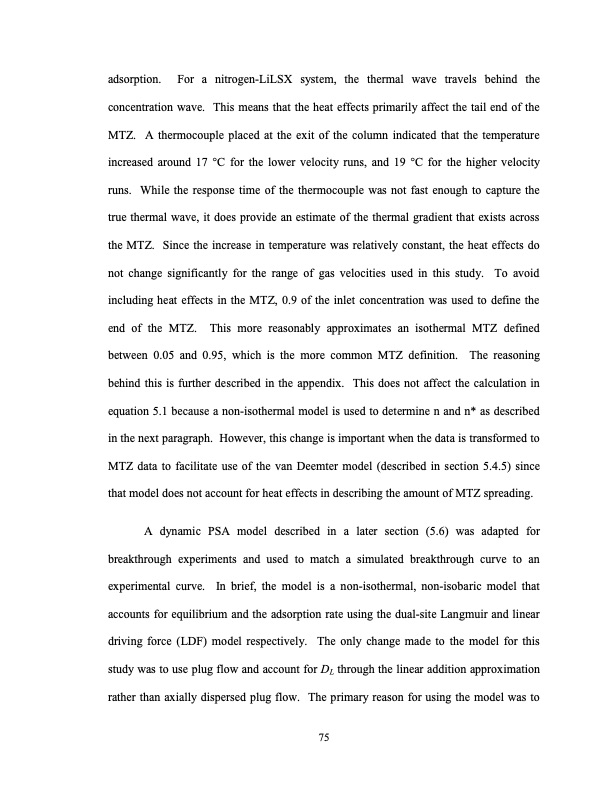
PDF Publication Title:
Text from PDF Page: 094
adsorption. For a nitrogen-LiLSX system, the thermal wave travels behind the concentration wave. This means that the heat effects primarily affect the tail end of the MTZ. A thermocouple placed at the exit of the column indicated that the temperature increased around 17 °C for the lower velocity runs, and 19 °C for the higher velocity runs. While the response time of the thermocouple was not fast enough to capture the true thermal wave, it does provide an estimate of the thermal gradient that exists across the MTZ. Since the increase in temperature was relatively constant, the heat effects do not change significantly for the range of gas velocities used in this study. To avoid including heat effects in the MTZ, 0.9 of the inlet concentration was used to define the end of the MTZ. This more reasonably approximates an isothermal MTZ defined between 0.05 and 0.95, which is the more common MTZ definition. The reasoning behind this is further described in the appendix. This does not affect the calculation in equation 5.1 because a non-isothermal model is used to determine n and n* as described in the next paragraph. However, this change is important when the data is transformed to MTZ data to facilitate use of the van Deemter model (described in section 5.4.5) since that model does not account for heat effects in describing the amount of MTZ spreading. A dynamic PSA model described in a later section (5.6) was adapted for breakthrough experiments and used to match a simulated breakthrough curve to an experimental curve. In brief, the model is a non-isothermal, non-isobaric model that accounts for equilibrium and the adsorption rate using the dual-site Langmuir and linear driving force (LDF) model respectively. The only change made to the model for this study was to use plug flow and account for DL through the linear addition approximation rather than axially dispersed plug flow. The primary reason for using the model was to 75PDF Image | LIMITS OF SMALL SCALE PRESSURE SWING ADSORPTION

PDF Search Title:
LIMITS OF SMALL SCALE PRESSURE SWING ADSORPTIONOriginal File Name Searched:
Limits of Small Scale PSA_Aaron Moran.pdfDIY PDF Search: Google It | Yahoo | Bing
CO2 Organic Rankine Cycle Experimenter Platform The supercritical CO2 phase change system is both a heat pump and organic rankine cycle which can be used for those purposes and as a supercritical extractor for advanced subcritical and supercritical extraction technology. Uses include producing nanoparticles, precious metal CO2 extraction, lithium battery recycling, and other applications... More Info
Heat Pumps CO2 ORC Heat Pump System Platform More Info
| CONTACT TEL: 608-238-6001 Email: greg@infinityturbine.com | RSS | AMP |